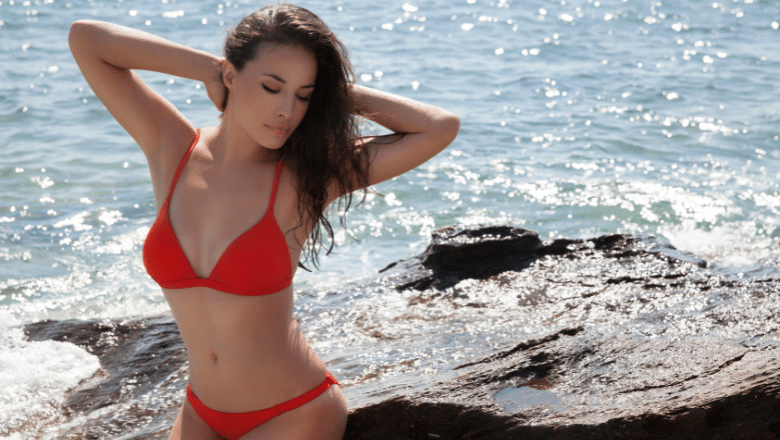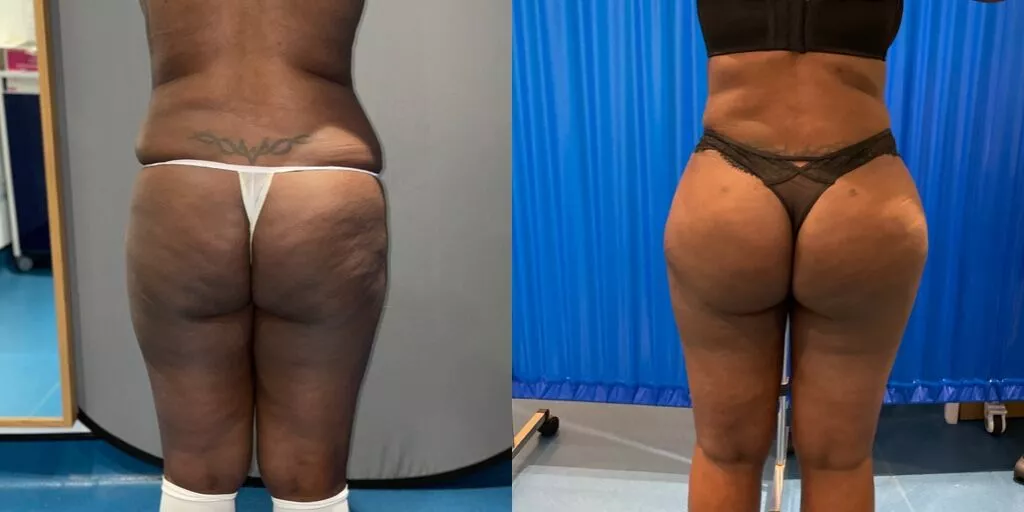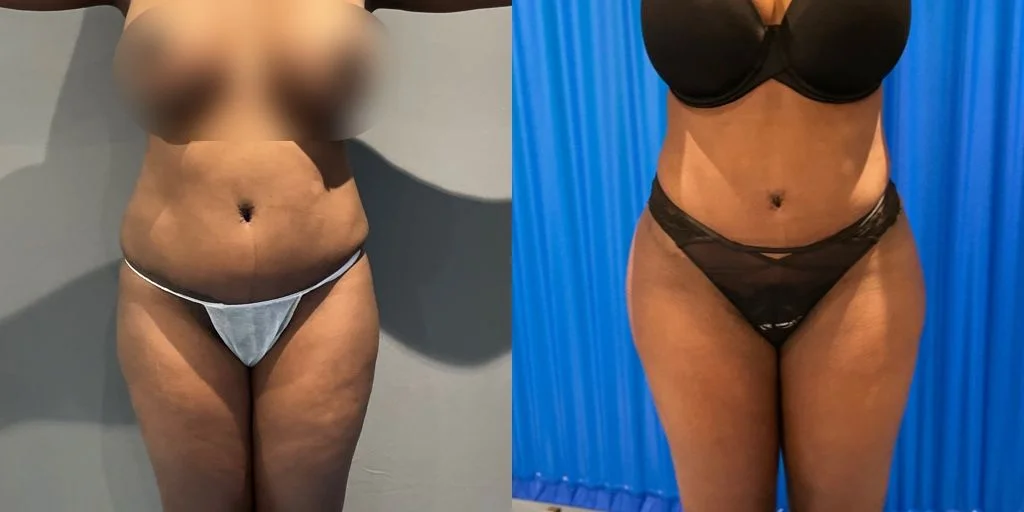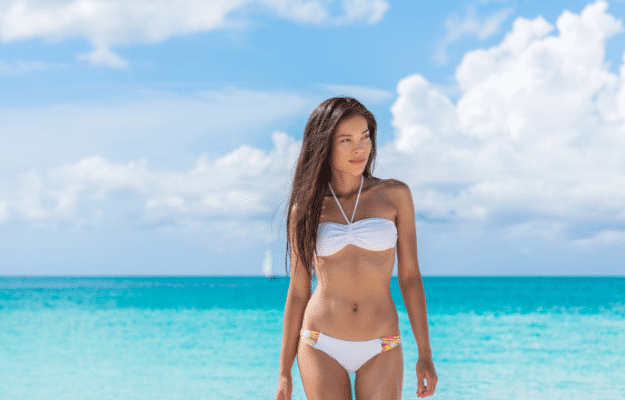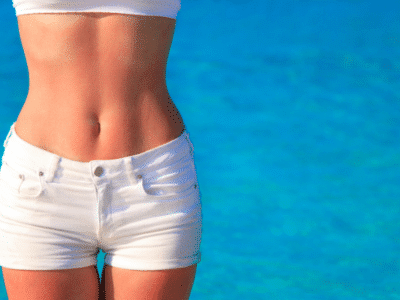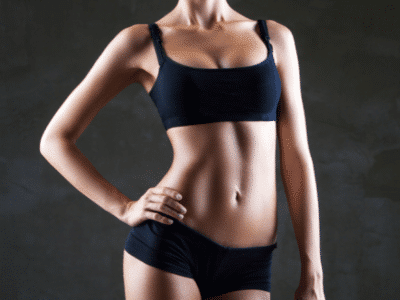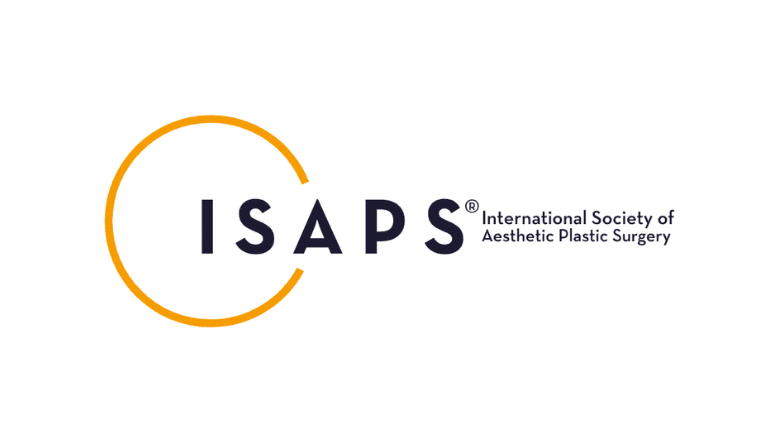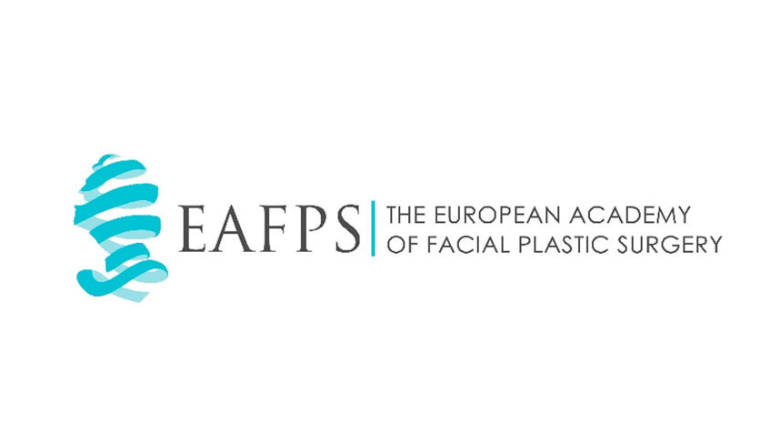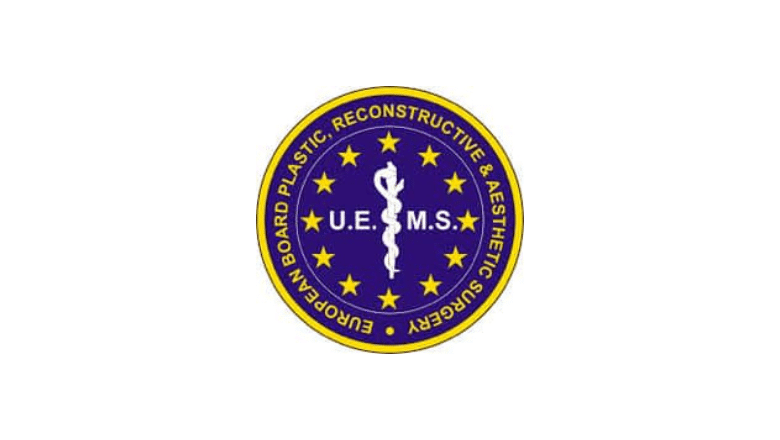Fat Transfer & Grafting London
In the realm of plastic surgery, attitudes towards fat have shifted dramatically, transitioning from disliking it to appreciating its value. Perhaps “dislike” is too strong a term – it’s not that fat was ever truly despised, but rather that its potential is now more fully recognised when it’s situated in just the right spots. This has led to the increasing popularity of fat transfer procedures, such as facial fat grafting, breast augmentation with fat transfer, and Brazilian butt lifts. When fat is perfectly distributed, it becomes a highly desirable asset.
However, it’s essential to acknowledge that fat can be somewhat unpredictable. Not all of the transferred fat will necessarily survive, and it does age, as it is a natural component of your body. Fat transfer procedures involve removing fat from one part of the body, processing it, and then injecting it into another area. This process requires the fat to adapt to a new environment within the body, which can occasionally be challenging.
Nonetheless, there are strategies to maximise the benefits of your fat transfer procedure and ensure that the results are preserved for as long as possible. By following appropriate pre-and post-operative care, selecting a skilled and experienced plastic surgeon, maintaining a stable weight, and adopting a healthy lifestyle, you can enhance the likelihood of a successful fat transfer and long-lasting results.
Individual outcomes may vary, and not all patients will experience the same results. Consult with a qualified plastic surgeon at Centre for Surgery to discuss your specific needs, expectations, and to better understand the potential risks and benefits of fat transfer procedures. By taking the time to make an informed decision, you can increase the chances of a successful outcome and enjoy the benefits of a well-executed fat transfer.
Why Choose Centre for Surgery for Fat Transfer?
When considering a fat transfer procedure, selecting a clinic with a proven track record of success, advanced technological capabilities, and a commitment to patient safety and satisfaction is crucial. Centre for Surgery stands out as a premier choice for those seeking fat grafting services in London. Here are compelling reasons to choose our clinic for your fat transfer needs:
Extensive Experience and Expertise
Centre for Surgery is distinguished by its extensive experience in fat grafting procedures. Our surgeons are not just skilled; they are artisans who perform hundreds of procedures annually, sculpting and enhancing multiple parts of the body to meet the unique desires of each patient. This vast experience ensures that we are well-equipped to handle a wide range of requests, from subtle enhancements to significant transformations.
Specialisation in Brazilian Butt Lift (BBL) and Breast Augmentation
Our clinic is particularly renowned for its unique and safe approach to using fat grafting for Brazilian Butt Lift (BBL) and breast augmentation procedures. These treatments require a high level of precision, understanding of body aesthetics, and an ability to balance proportion and shape for natural-looking results. Our surgeons’ expertise in these areas has made Centre for Surgery a sought-after destination for patients looking to enhance their silhouette.
State-of-the-Art Liposuction Technologies
We leverage a myriad of advanced liposuction technologies and surgical techniques to ensure the best outcomes for our patients. From Micro Liposuction to Power-Assisted Liposuction (PAL) and BodyTite, our arsenal of tools allows us to tailor the fat removal process to each patient’s specific needs, ensuring minimal invasiveness, reduced recovery times, and optimal results.
Customised Surgical Approaches
Understanding that every patient’s body and aesthetic goals are unique, we place a strong emphasis on customised surgical planning. During a consultation at our Baker Street clinic in the heart of Marylebone, our team takes the time to discuss your concerns, goals, and the most suitable surgical approaches for attaining your desired results. This personalised planning ensures that each patient’s journey is tailored to their individual needs and expectations.
Commitment to Safety and Patient Satisfaction
At Centre for Surgery, patient safety and satisfaction are at the core of everything we do. Our surgeons and support staff are dedicated to providing a safe, comfortable, and supportive environment from the initial consultation through to recovery and beyond. Our unique and safe approaches, particularly in high-demand procedures like BBL and breast augmentation, demonstrate our commitment to achieving your aesthetic goals while prioritising your well-being.
Book Your Consultation Today
If you’re interested in enhancing your appearance with a fat transfer in London, Centre for Surgery offers the expertise, technology, and personalised care you need to achieve your aesthetic goals. Contact us to book a consultation at our Baker Street clinic in Marylebone, and take the first step towards a more confident and satisfied you.
What Is Fat Transfer?
Fat transfer, also known as fat grafting or lipofilling, is a transformative cosmetic surgery technique that reshapes and enhances one’s physique by relocating fat from surplus areas to regions desiring volume. This dual-purpose method not only carves and defines the areas from which fat is extracted but also volumises and accentuates the recipient sites for a harmoniously balanced silhouette.
The procedure unfolds through a meticulous multi-step process. Initially, fat is carefully harvested from areas marked by excess, such as the abdomen, thighs, upper arms, and back, utilising the technique of liposuction. This gathered fat undergoes a purification process to eliminate any impurities, ensuring that only the highest quality fat cells are re-injected into the designated areas seeking enhancement. Common recipient sites include the breasts, buttocks, and calves, where the introduction of fat adds natural-looking fullness and contour.
A significant number of patients exhibit a preference for fat transfer over synthetic implants due to the innate advantages it offers. Utilising one’s own fat cells mitigates the risk of allergic reactions often associated with foreign materials. Moreover, fat transfer yields results that are both visually and tactilely natural, offering a subtlety that synthetic implants struggle to match.
Beyond its capacity to augment and sculpt larger body areas, fat transfer proves versatile in its ability to address finer details. Smaller quantities of fat can be strategically relocated to diminish the visibility of wrinkles and age-related volume loss in areas such as the hands, face, and neck, further showcasing the procedure’s flexibility in enhancing natural beauty and youthfulness.
Benefits of Fat Transfer
Fat transfer, also known as autologous fat grafting or fat injection, is a cosmetic procedure that involves harvesting fat from one area of the body and injecting it into another area to improve volume, contour, or appearance. This technique has gained popularity due to its various benefits:
Natural results
Since the procedure uses your own fat, it provides a more natural look and feel compared to synthetic fillers or implants.
Biocompatibility
As the fat comes from your body, there’s a lower risk of allergic reactions or complications related to foreign materials.
Long-lasting effects
Fat transfer results can be long-lasting, particularly when performed by an experienced surgeon. Although some of the transferred fat may be reabsorbed by the body, a significant portion can remain and provide lasting results.
Dual benefit
The procedure not only enhances the area receiving the fat but also helps contour the area where the fat is harvested from, such as the abdomen or thighs.
Minimally invasive
Fat transfer is less invasive than some other cosmetic procedures, typically requiring only small incisions for fat harvesting and injection.
Quick recovery
The recovery time for fat transfer is generally shorter than more invasive procedures, such as implants or major surgery. Most patients can resume normal activities within a few days to a week.
Versatility
Fat transfer can be used for various cosmetic enhancements, including facial rejuvenation, breast augmentation, buttock augmentation, and treatment of scars or other contour irregularities.
Reduced risk of complications
Compared to implants or other synthetic materials, fat transfer has a lower risk of complications such as infection, rupture, or displacement.
Ideal candidates for fat transfer surgery
Fat transfer is a commonly performed procedure at Centre for Surgery and our surgeons are known for achieving excellent outcomes for their patients. The best outcomes after that transfer surgery depend on selecting the appropriate candidate at the outset. Ideal patients for fat transfer should:
- Be in a good state of physical and mental health with no uncontrolled medical conditions such as diabetes
- Patients should be at or near their optimum body weight
- Patients have realistic expectations of what results to expect with fat rafting to the body
- Patients are looking for a long-lasting natural alternative to volume enhancement that does not involve the use of hyaluronic acid filler or silicone implants
- Patients would like to improve their body shape without more invasive surgery using a combination of liposuction and fat grafting
- Patients are keen to improve their overall skin quality and enhance their appearance through natural rejuvenation with their own body fat
Innovative Fat Transfer Techniques
EVL (Expansion, Vibration, Lipofilling)
EVL (Expansion, Vibration, Lipofilling) is a cutting-edge technique in Brazilian Butt Lift surgery, which combines liposuction to remove unwanted fat from target areas and subsequent fat injection into the buttocks to enhance their shape and size. In the past, direct fat injection into the gluteal muscles was a common approach, but this method led to some serious complications.
Dr Simeon Wall Jr. in the USA pioneered EVL. This technique optimises shaping and increases the volume of fat that can be safely injected into the subcutaneous (fatty) tissue of the buttocks. By avoiding fat injections into the gluteal muscles, the risk of severe complications, such as macrofat embolism, is significantly reduced. Centre for Surgery was among the first clinics in the UK to adopt the EVL technique years ago, positioning itself at the forefront of innovation in this field.
EVL offers several benefits compared to traditional fat transfer methods. The technique is designed to minimise trauma to the harvested fat cells, increasing their chances of survival once injected into the buttocks. Additionally, the use of vibration during the procedure helps in evenly distributing the fat, leading to smoother and more natural-looking results.
When considering a Brazilian Butt Lift, it’s essential to choose a plastic surgeon experienced in the EVL technique, as this can significantly impact procedure safety, effectiveness, and longevity. Consult with a certified plastic surgeon at Centre for Surgery who has demonstrated expertise in performing EVL-based Brazilian Butt Lift procedures to ensure the best possible outcome.
Micro and Nano Fat Grafting Options
For those looking for more specific or targeted fat transfer options, we offer micro and nano fat grafting procedures at our London clinic.
Micro Fat Grafting
Micro fat grafting is a tailored procedure designed to add small volumes of fat to specific areas that need a little boost. We obtain these fat cells through a liposuction process and then inject them through smaller incisions. The benefit of these smaller incisions is that they leave very minimal scarring. This type of fat grafting is great for addressing cosmetic issues like sagging skin, fine lines, and wrinkles. It’s especially useful for parts of the body where these concerns are more evident, like the hands, neck, and décolletage.
Nano Fat Transfer
Nano fat transfer goes a step further by mixing and breaking down the fat at the cellular level to harness the potential of the fat’s stem cells. These stem cells are crucial for skin rejuvenation. When injected back into the skin, they can enhance the texture, firmness, and overall appearance of your skin. This approach is also effective for targeting specific cosmetic issues such as scarring, providing a more holistic skin improvement.
Both these specialised fat grafting options offer unique advantages, and the best choice will depend on your individual needs and aesthetic goals.
Fat Transfer vs. Implants: A Comparison
When considering body enhancement options, many people find themselves deciding between fat transfer and implants. Here is a straightforward comparison of the two, to help you make a more informed decision.
RELATED: Breast Implants vs. Fat Transfer – Which Is Best For You?
Results
- Fat Transfer: Offers a subtle enhancement to one area of the body while also toning another area by removing excess fat.
- Implants: Provides a more substantial and dramatic enhancement to the treatment area.
Anaesthetic
- Fat Transfer: This can be carried out with IV sedation or general anaesthetic, although micro and nano fat transfers may use local anaesthetic.
- Implants: Always performed under general anaesthetic.
Scarring
- Fat Transfer: Leaves minimal scarring due to smaller incisions.
- Implants: Scarring is more noticeable as it is typically at the site of the larger incisions needed to insert the implants.
Recovery Time
- Fat Transfer: Typically requires a shorter 4-6 week recovery period.
- Implants: Generally requires around 6 weeks for full recovery.
Longevity of Results
- Fat Transfer: The results are permanent, although they may be influenced by significant weight fluctuations.
- Implants: They also offer permanent results but may require replacement or adjustment over time.
Price
- Fat Transfer: The cost is dependent on the area being treated but is typically less expensive than implants.
- Implants: Generally more expensive than fat transfer procedures.
Target Areas for Fat Transfer
Facial Fat Transfer
Facial fat grafting, also known as fat transfer or fat injection, is a cosmetic surgical procedure that involves removing fat from one area of the body, such as the thighs or abdomen, and transferring it to the face to add volume, improve contour, and restore a more youthful appearance.
During the procedure, the surgeon will use a thin cannula to harvest fat from the donor site. The harvested fat is then purified and prepared for injection into the desired areas of the face, such as the cheeks, under-eye area, temples, and jawline.
Facial fat grafting is often performed as a standalone procedure or in combination with other facial rejuvenation procedures, such as facelift, brow lift, or eyelid surgery. It is considered a safe and effective way to enhance facial features, especially for those who have lost facial volume due to ageing, weight loss, or other factors.
Fat Transfer Breast Augmentation
Fat transfer to breasts, also known as autologous fat transfer or fat grafting to the breast, is a cosmetic surgical procedure that involves removing fat from one area of the body, such as the thighs, abdomen, or hips, and transferring it to the breasts to increase their size and improve their shape.
RELATED: Fat Transfer Breast Augmentation FAQs – Q&A about Fat Transfer to Breast
During the procedure, the surgeon will use a thin cannula to harvest fat from the donor site. The harvested fat is then processed and purified before being injected into the breast tissue. The amount of fat injected depends on the desired outcome and the amount of available donor fat.
Fat transfer to breasts is often used as an alternative to breast augmentation with implants. It is considered a safe and effective way to enhance breast size and shape while providing a natural look and feel to the breasts. Additionally, fat transfer to breasts has the added benefit of reducing fat in the donor area, resulting in a more contoured appearance overall. However, it is important to note that the results of fat transfer to breasts may not be as dramatic as those achieved with breast implants and may require multiple sessions to achieve the desired outcome.

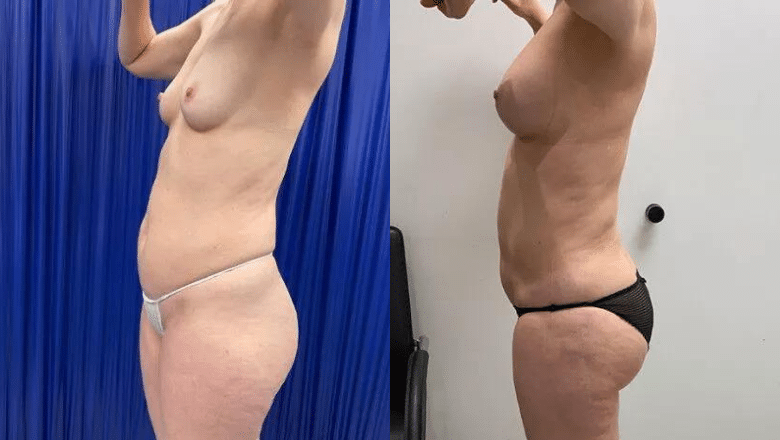
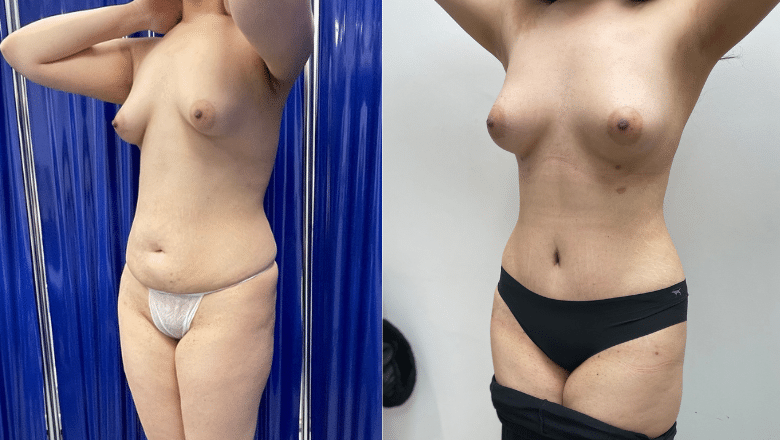
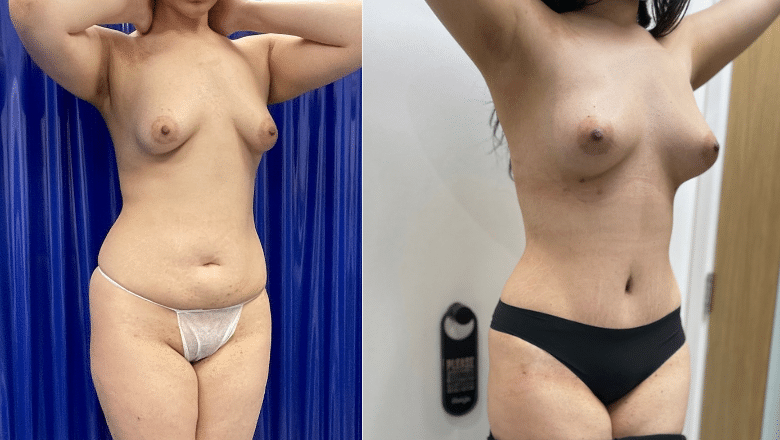
Brazilian Butt Lift (BBL)
A Brazilian butt lift (BBL) is a cosmetic surgical procedure that involves transferring fat from one area of the body, such as the abdomen, hips, or thighs, to the buttocks to enhance their size, shape, and contour.
During the procedure, the surgeon will use a thin cannula to harvest fat from the donor site. The harvested fat is then processed and purified before being injected into various areas of the buttocks to achieve the desired shape and contour. The amount of fat injected depends on the patient’s body type, desired outcome, and available donor fat.
Brazilian butt lifts are often performed as a standalone procedure, but they can also be combined with other body contouring procedures, such as liposuction, tummy tuck, or thigh lift, to achieve a more comprehensive result.
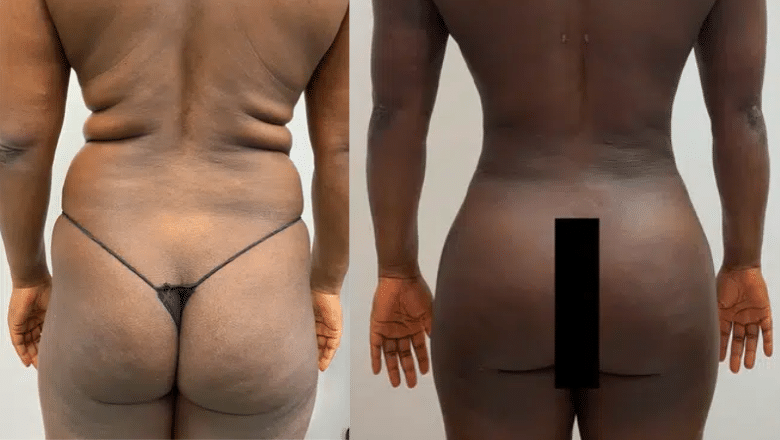
Case 3:
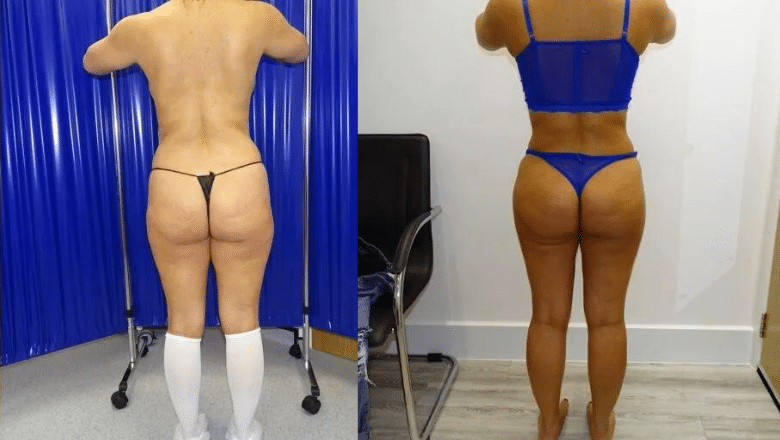

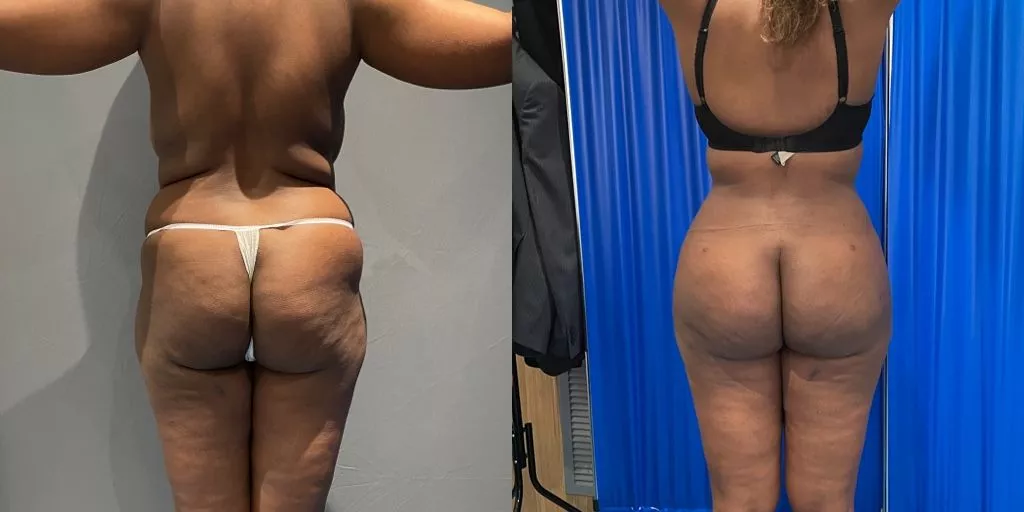
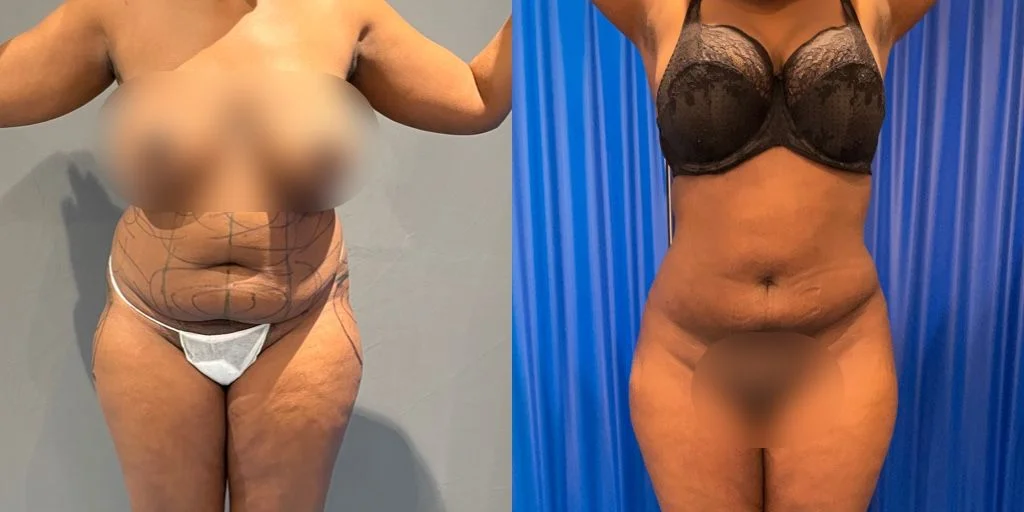
Case 5:
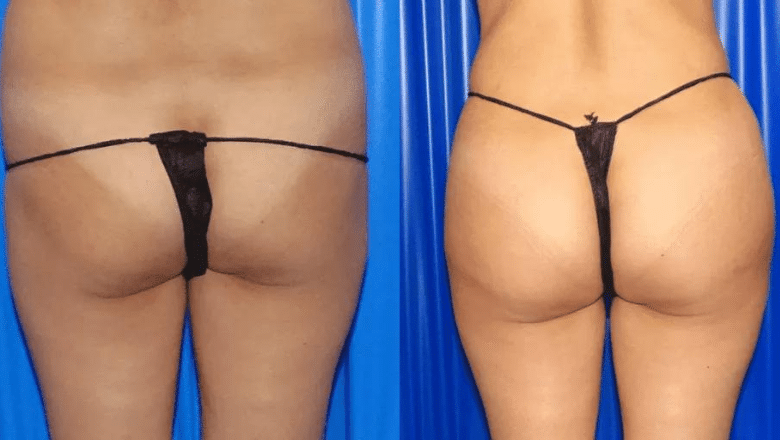
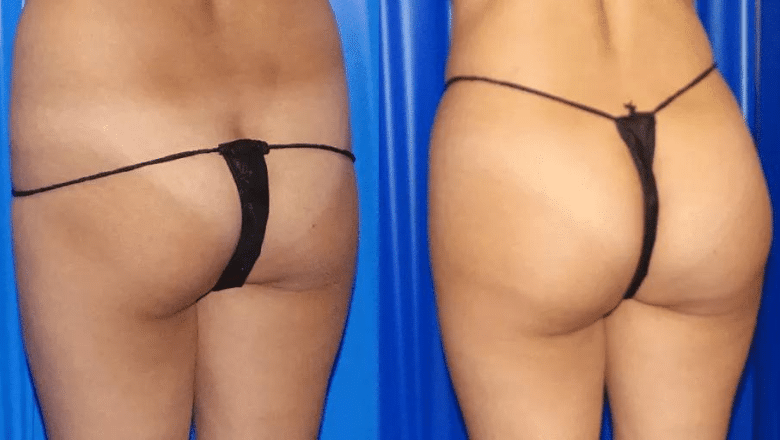
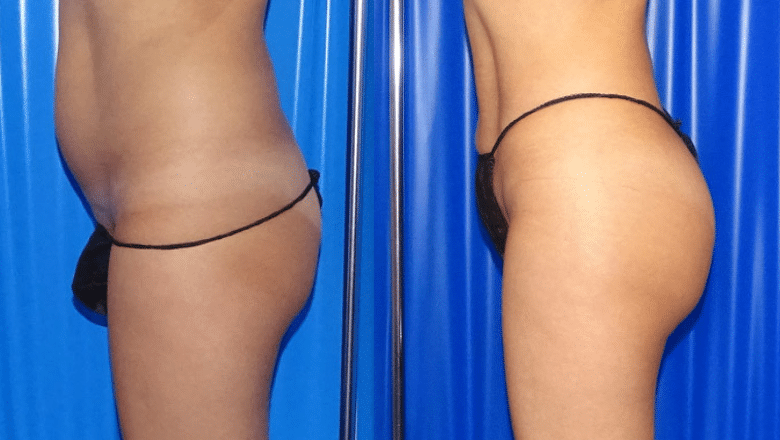

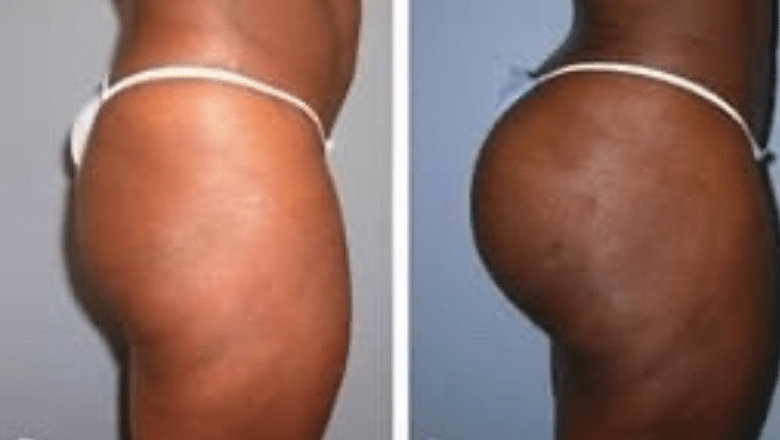
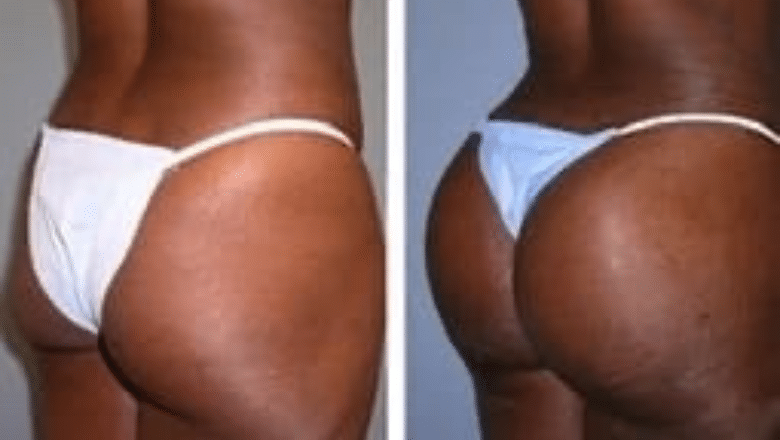
Calf augmentation with fat grafting
Calf augmentation with fat grafting, also known as calf lipofilling or calf fat transfer, is a cosmetic surgical procedure that involves using a patient’s own fat to enhance the shape and size of their calves.
During the procedure, the surgeon will use a thin cannula to harvest fat from one or more donor areas of the patient’s body, such as the abdomen, hips, or thighs. The harvested fat is then processed and purified before being injected into various areas of the calves to create a more shapely and defined appearance.
Calf augmentation with fat grafting is often recommended for individuals who have disproportionately small or thin calves, which can be a source of self-consciousness and dissatisfaction with their appearance. Compared to calf implants, which are silicone devices inserted into the calves to enhance their size, calf augmentation with fat grafting is considered a more natural and less invasive option.
Rejuvenating Ageing Hands: Micro and Nano Fat Transfer Solutions
The hands are not only crucial for daily function but also play a significant role in our social interactions and how we present ourselves to the world. Unfortunately, they are often the first area of the body to betray signs of ageing. Over time, the loss of subcutaneous fat leads to more pronounced veins, tendons, and a change in the skin’s texture and elasticity, resulting in a more aged appearance. At Centre for Surgery, we understand the importance of addressing these concerns to restore a youthful and revitalised look to your hands.
RELATED: Our Top Treatments for Hand Rejuvenation
Understanding the Ageing Process in Hands
As we age, our hands lose fat and volume, leading to flaccid skin and making veins and tendons more visible. This process is exacerbated by environmental factors, such as sun exposure, which can also affect the skin’s texture and elasticity. The hands can often give away a person’s age, even if the rest of their body and face remain youthful and vibrant.
Micro Fat Transfer: A Precise Volume Enhancement
Micro fat transfer is an innovative technique designed to address the volume loss in the hands. By carefully injecting small amounts of fat harvested from another area of the body, we can add volume to the hands, making veins and tendons less visible and giving the skin a plumper, more youthful appearance. This procedure is minimally invasive, offers long-lasting results, and has the added benefit of using the patient’s own body tissue, reducing the risk of allergic reactions or rejection.
Nano Fat Transfer: Advanced Skin Rejuvenation
In addition to micro fat transfer, Centre for Surgery also offers nano fat transfer for hand rejuvenation. This technique involves processing the harvested fat to isolate the smallest fat particles, rich in stem cells and growth factors. When injected into the hands, these particles can improve skin quality, texture, and elasticity, leading to a more refined and youthful appearance. Nano fat transfer is particularly effective for improving the skin’s surface quality and can be used in conjunction with micro fat transfer for comprehensive hand rejuvenation.
Fat Grafting Procedure
Fat grafting, also known as fat transfer, is an innovative cosmetic surgery technique that enhances and rejuvenates areas of the body by transferring fat from one part of the body to another. This two-stage procedure involves liposuction to harvest excess fat and its subsequent transfer to areas requiring volume enhancement. At Centre for Surgery, we are at the forefront of employing advanced technologies to ensure optimal outcomes and patient satisfaction.
Stage 1: Liposuction – The Foundation of Fat Grafting
Understanding the Liposuction Process
The journey to a more sculpted body begins with the administration of an anaesthetic, ensuring a comfortable experience for our patients. A small incision is made to introduce a thin cannula into the targeted area, marking the start of the liposuction process. This crucial first step is not only about removing excess fat but also about reshaping and contouring the body to achieve a more aesthetically pleasing silhouette.
Advanced Liposuction Technologies
At Centre for Surgery, we pride ourselves on utilising a spectrum of cutting-edge liposuction technologies to cater to the unique needs of our patients. These include:
- Micro Liposuction: Ideal for precise fat removal in delicate areas, ensuring minimal invasiveness.
- Power-Assisted Liposuction (PAL): Enhances the efficiency of fat removal through a mechanised cannula, offering smoother results.
- BodyTite: A radiofrequency-assisted liposuction technique that not only removes fat but also tightens the skin, providing a dual benefit.
Our commitment to employing the latest in liposuction technology underscores our dedication to achieving the best possible outcomes for our patients, with an emphasis on safety, efficacy, and patient satisfaction.
Stage 2: Fat Transfer – Sculpting with Precision
Purification and Preparation of Fat Cells
Once the fat has been harvested, it undergoes a meticulous washing and purification process. This critical step ensures that only the highest quality fat cells are selected for reinjection, maximising the potential for successful grafting.
Innovative Techniques for Fat Injection
Before reinjection, small, strategic incisions are made in the recipient areas. This is where the purified fat cells will be carefully and precisely injected to enhance volume and contour. At Centre for Surgery, we utilise an ultrasound-guided fat placement technique to ensure the precise delivery of fat cells, enhancing safety and improving the longevity of the results. This method significantly reduces the risk of complications, such as fat migration or leakage, by providing real-time visualisation during the procedure.
Closing the Chapter: Final Touches
After the fat has been successfully transferred, the incisions are meticulously closed with medical-grade sutures, marking the end of the procedure. Our surgeons at Centre for Surgery take great care to ensure that the incisions are as inconspicuous as possible, minimising any potential scarring and promoting a smoother recovery.
Why Choose Centre for Surgery for Your Fat Grafting Procedure?
At Centre for Surgery, we are dedicated to providing our patients with personalised care, utilising state-of-the-art technologies and techniques to ensure optimal results. Our experienced plastic surgeons are experts in the art and science of fat grafting, committed to enhancing your natural beauty and confidence.
Whether you’re looking to add volume to the face, breasts, buttocks, or any other area lacking in fullness, fat grafting offers a natural and effective solution. We invite you to contact us to learn more about how fat grafting can help you achieve your aesthetic goals in a safe and effective manner.
Recovery after Fat Grafting
Recovery after fat transfer surgery varies depending on the individual and the specific procedure performed. Here are some general guidelines and tips for a smooth recovery process:
- Swelling and bruising: Expect some swelling, bruising, and discomfort in both the donor and recipient areas. These side effects typically subside within a few weeks. Using cold compresses and elevating the treated area can help alleviate swelling.
- Pain management: Your surgeon may prescribe pain medication to help manage discomfort during the initial recovery phase. Follow the prescribed dosage and instructions.
- Compression garments: You may be advised to wear compression garments on the donor and recipient sites to reduce swelling, improve circulation, and support the healing process. Follow your surgeon’s recommendations on how long to wear the garments.
- Activity restrictions: Avoid strenuous activities and exercise for the first few weeks after surgery, as directed by your surgeon. Gradually resume activities as you feel comfortable and receive clearance from your doctor.
- Rest: Ensure you get plenty of rest during the recovery period. Sleep with your head elevated to reduce swelling and follow any specific positioning instructions provided by your surgeon.
- Hydration and nutrition: Stay well-hydrated and maintain a balanced diet to support your body’s healing process. Avoid smoking and limit alcohol consumption, as these can impede healing.
- Follow-up appointments: Attend all follow-up appointments with your surgeon to monitor your progress and address any concerns or questions.
- Incision care: Keep incisions clean and dry, and follow your surgeon’s instructions regarding wound care and bathing.
- Signs of complications: Be aware of any signs of infection or complications, such as increased pain, redness, pus, or fever. Contact your surgeon immediately if you notice any of these symptoms.
- Patience: Remember that it can take several months for the final results of the fat transfer procedure to become apparent. Be patient and give your body time to heal and adjust.
Always follow your surgeon’s specific post-operative instructions for the best recovery experience and outcome. If you have any concerns or questions during your recovery, don’t hesitate to reach out to your surgeon for guidance.
What Are The Potential Risks of Fat Transfer?
When performed by specialist plastic surgeons with expertise in body contouring, fat grafting is a very safe procedure with a favourable risk profile. Nonetheless, all types of cosmetic surgery carry risks, and fat grafting is no different. There are several side effects which patients should expect to experience after the lipofilling procedure, including:
- Temporary numbness or paraesthesia
- Bruising and swelling, which is temporary in nature and will resolve after the first 5 to 7 days
- A minimal degree of scarring thanks to incisions that are no longer than 3 to 4 mm in length
- A small amount of fat reabsorption, which is a normal phenomenon that occurs with all fat transfer procedures and most commonly occurs during the first couple of weeks
- Bleeding
- Infection
- Fat necrosis
- Haematoma or seroma
- Contour abnormalities which may necessitate a further fat grafting procedure
At your consultation, your surgeon will cover all the risks and complications associated with fat grafting and the precautions that are to be taken to minimise such risks. We encourage all patients to carry out as much research as possible so that they are fully informed about all aspects of the procedure.
Fat Transfer Surgery Costs London - How much does fat transfer cost in London UK? Prices & Fees
The cost of fat transfer surgery in London, UK, can vary depending on several factors, including the specific procedure, the surgeon’s experience and qualifications, the location of the clinic, and the complexity of the case.
At Centre for Surgery, a leading cosmetic and plastic surgery clinic based in London, the cost of fat transfer surgery starts from £3,900. This includes a comprehensive consultation with a specialist surgeon, the surgery itself, anaesthesia, and post-operative care.
However, the exact cost of fat transfer surgery will depend on the specific procedure being performed, the amount of fat to be transferred, and other individual factors. For example, fat transfer to the face may be less expensive than fat transfer to the breasts or buttocks, as it requires less fat to be transferred and less time in the operating room.
Selecting a Plastic Surgeon with Fat Transfer Expertise
Choosing a skilled and experienced plastic surgeon for your fat transfer procedure is the top priority for any surgical endeavour. Apart from ensuring the best results and longevity, prioritising your safety is of utmost importance.
When it comes to procedures like the Brazilian butt lift, which involves harvesting fat from one area of the body and injecting it into the target areas of the buttocks, the surgeon’s technique and experience play crucial roles.
Generally, only about 50% of the transferred fat survives in any fat transfer procedure. This is entirely normal, and a proficient surgeon will take the loss of fat cells into account. However, to maximise fat cell survival in the new area, your surgeon must possess the expertise to know precisely where and how to inject the fat cells.
Furthermore, fat cells must be carefully harvested and purified before being injected. It’s essential that your surgeon utilises the most advanced and efficient harvesting tools available.
While you may desire fat removal from specific areas with excess fat, the healthiest fat is often found around the abdomen and thighs. Consequently, an experienced surgeon will typically harvest fat from these regions for optimal results.
Why choose Centre for Surgery for Fat Transfer Surgery?
Centre for Surgery is a leading cosmetic and plastic surgery clinic based in London, UK. There are several reasons why someone may choose to undergo fat transfer surgery at Centre for Surgery, including:
- Highly qualified and experienced surgeons: All of the surgeons at Centre for Surgery are GMC certified and have extensive experience in performing fat transfer surgery. They use the latest techniques and technologies to achieve the best possible results for their patients.
- State-of-the-art facilities: Centre for Surgery is equipped with state-of-the-art facilities and technology at our Baker Street clinic to ensure the highest standards of safety and quality for patients.
- Patient-centred approach: At Centre for Surgery, the patient’s needs and goals are always the top priority. The team of experts takes the time to listen to each patient’s concerns and work with them to develop a customised treatment plan that meets their unique needs and expectations.
- Comprehensive aftercare: Centre for Surgery provides comprehensive aftercare for all of its patients, including follow-up appointments and ongoing support to ensure the best possible outcome and recovery.
- Excellent patient reviews: Centre for Surgery has an excellent reputation and has received numerous positive reviews from satisfied patients who have undergone fat transfer surgery and other cosmetic procedures at the clinic.
FAQs
-
What is Autologous Fat Grafting?Fat transfer surgery is also known as fat grafting or "lipofilling" and is an advanced body contouring technique designed to enhance volume in one part of the body with the simultaneous removal of fat from another part.
The fat grafting procedure is commonly performed at Centre for Surgery in London and involves the removal of excess fat deposits using liposuction from areas including the abdomen, thighs or back. The removed fat is then processed to remove impurities before being injected into another part of the body, such as the breasts, buttocks, or calves. The fat transfer procedure is one of the most effective ways of volume enhancement without the need for artificial implants and can be used in patients for a wide range of applications, including correcting loose or saggy skin as part of the ageing process or for patients who have lost significant amounts of weight and present with unsightly areas of volume loss. Research has also demonstrated that newly transferred fat cells also enhance the vascular supply and contribute to improving the quality of the skin as a result of the presence of growth factors and other nutrients, which have a powerful anti-ageing effect. Fat grafting can also be used for scar revision, and the use of micro fat and nano fat is well established for improving the appearance of a wide variety of scars, including acne scars and atrophic scarring. The primary purpose of any fat transfer procedure is to restore soft tissue volume to the area where fat grafting is performed.
Fat transfer surgery has evolved to become a very safe and effective surgical technique for treating a wide range of aesthetic concerns with excellent long-term results. Fat transfer is a natural type of volume restoration as it does not involve silicone implants or hyaluronic acid fillers and has become the technique of choice for patients who are not keen on using artificial substances for volume enhancement. In expert hands, surgeons can achieve a fat survival rate of at least 60 to 80% in appropriately selected patients. All types of fat transfer procedures are minimally invasive without the need for extensive incisions, and the recovery period is often much quicker compared with more traditional excess skin removal surgery. Our surgeons are experts in positioning incisions for fat transfer in natural body folds to minimise the appearance of scars. Most patients who have a fat transfer procedure often have great difficulty identifying where their scars are located.
Centre for Surgery is home to some of the UK's foremost fat transfer experts and are pioneers in carrying out Brazilian Butt Lift (BBL) surgery using only the safest methods and is one of the most experienced centres for hybrid breast augmentation, which involves the use of both silicone breast implants and breast fat transfer for precise contouring and volume enhancement of the breast. -
Do I need to lose weight before getting a fat transfer?If you're considering a fat transfer, your Body Mass Index (BMI) should be lower than 30. If your BMI exceeds this threshold, you might want to consult with a dietician to help you reach a healthier weight before going ahead with the surgery. Achieving a lower BMI can make the procedure safer and the results more effective.
-
Does fat transfer to the breasts cause lumps?When performed by an experienced surgeon, a fat transfer to the breasts should not cause lumpiness. It's important to note that if you had any pre-existing lumps in your breasts, these might still be palpable post-procedure. A thorough consultation and possibly pre-operative imaging will help to address any concerns and plan the procedure accordingly.
-
Is It Possible to Have a Fat Transfer After Having Breast Implants?Combining breast implants with a fat transfer is not only possible but increasingly common. This approach allows for a more nuanced and natural-looking augmentation, particularly beneficial for individuals with minimal natural breast tissue. The added volume from the fat transfer can help to smooth out the contours and conceal the edges of the implants, leading to a more seamless integration with the body.
-
Can fat move after grafting?Once fat is grafted to a new area and has established a blood supply, it becomes a permanent part of that area and will not migrate. The integration process ensures that the fat cells are fixed and will behave like any other cells in the area, expanding or shrinking in response to weight changes but not moving from their new location.
-
How much does fat transfer cost?The cost of fat transfer surgery depends on the area of the body where liposuction is to be performed and where the fat is to be injected.
-
What can I expect after fat transfer surgery?Once the fat grafting procedure has taken place, you will be reviewed by a member of our post-operative nursing team one week following your procedure. At this appointment, your dressings will be removed and the surgical site will be inspected for evidence of adequate healing. Any permanent sutures that have been inserted will be removed at this appointment.
At the six week mark, you'll be reviewed by your surgeon to assess the results of the fat transfer procedure and to make sure that the results are in line with your expectations. Throughout your journey at Centre for Surgery, you have unlimited access to our expert post-operative nursing team, who are on hand to answer any of your questions or concerns.
After-care is not an afterthought at Centre for Surgery and we pride ourselves on the quality of our post-operative care, which has been described as outstanding by the Care Quality Commission. -
Is it possible for the transferred fat to move to another area?No, the fat that gets transferred won't suddenly shift to a different part of your body. Once it settles and bonds with the blood supply in the area it was transferred to, it becomes a natural part of your body structure.
-
When will I see fat transfer results?It's important to remember that the immediate appearance after your fat transfer procedure will not be the final outcome. Swelling is common following surgery, causing the treated area to appear larger than its eventual size.
It's not unusual for patients to feel disappointed with certain procedures like breast augmentation with fat transfer or Brazilian butt lifts, and in some cases, touch-ups may be needed after the initial recovery period. However, maintaining realistic expectations about the achievable results of fat transfer is crucial.
Allow your body ample time to adapt to the relocated fat cells. True results generally become apparent around three months after the procedure, but it's advisable to wait for six months to a year for the full results to manifest.
Your recovery process and adherence to your surgeon's post-operative guidelines will significantly impact the final outcome and its durability. Make sure to take it easy following your surgery, giving your body the time and rest it needs to heal properly. You might also need to modify your diet and exercise routine to accommodate your new body contours, ensuring that the results of the fat transfer procedure are long-lasting and satisfactory. -
Will a fat transfer to my breasts create lumps?If your surgery is performed by an experienced and competent surgeon, you shouldn't have any issues with lumps forming in your breasts post-procedure. If you had lumps in your breasts before the surgery, those might still be there afterward, but the transferred fat itself shouldn't cause new lumps.
-
Can I combine a fat transfer with breast augmentation?Yes, it's fairly common to combine breast augmentation with fat transfer for more natural-looking results. This is especially useful for people with less breast tissue, as the fat transfer can help disguise the edges of the implant, giving a smoother and more natural appearance.
-
What if I gain weight after having a fat transfer?Minor weight changes probably won't have a huge impact on your fat transfer results. However, if you gain a lot of weight, the transferred fat cells—as well as the fat cells in the rest of your body—can grow in size, affecting the outcome of your surgery. It's advisable to maintain a consistent weight to preserve the results.
-
Is a fat transfer painful?You won't feel pain during the fat transfer procedure itself as you'll be under deep sedation or general anaesthetic. After the surgery, your surgeon will provide you with prescriptions for pain relief to help you have a more comfortable recovery period.
-
How long do fat transfer results last?The outcomes of a fat transfer are designed to be permanent, with the caveat that maintaining a stable weight is crucial. Post-procedure, the newly transferred fat cells integrate with their new environment, adopting the characteristics of the surrounding tissue. This means that significant weight fluctuations can alter the appearance by causing these cells to either expand or shrink. Thus, a healthy and stable lifestyle is key to preserving the longevity of your results.
-
Is fat transfer permanent?While fat transfer can provide long-lasting results, it is not necessarily permanent, as some of the transferred fat may be reabsorbed by the body. Generally, around 50% to 80% of the transferred fat survives and integrates into the recipient site, while the remaining fat is gradually reabsorbed over time. The survival rate of the transferred fat can be influenced by factors such as the patient's overall health, the quality of the donor fat, the technique used for harvesting and injecting the fat, and the recipient area's blood supply.
To account for fat reabsorption, surgeons may initially overfill the treated area, anticipating that a certain percentage of the fat will not survive. The final results may take several months to become apparent as the body adjusts and the swelling subsides. To maintain the desired results, additional fat transfer procedures or touch-up treatments may be necessary. -
What is autologous fat transfer surgery?Autologous fat transfer is the medical term used to describe fat grafting surgery. The term autologous refers to the fact that the harvested fat comes from the same patient and is injected into the same patient.
It, therefore, follows that all that grafting methods are in fact autologous fat transfer treatments. -
Is getting a fat transfer worth it?Many people find fat transfer procedures to be very beneficial, especially those who want to enhance specific body areas. Fat transfers are gaining popularity in the UK because of their versatility. They can add volume to areas that lack it, while also removing stubborn, diet-resistant fat from other areas. Plus, fat transfers offer a more permanent solution compared to dermal fillers and a more natural alternative to implants, making it a worthwhile option for many.
What To Expect
Consultation
During your first meeting with us, we'll talk about what you're hoping to achieve with a fat transfer. It's important to have a clear idea of your expectations, as we can then discuss what's realistic for you, based on the procedure. We'll also go over your medical history. This helps us understand whether you're a good candidate for the surgery and lets us spot any potential risks that might be involved.
For certain fat transfer procedures, like Brazilian Butt Lifts (BBLs), we offer something extra special: 3D consultations. This means we'll use photos of your own body to give you a virtual glimpse of what you could look like after the surgery. This adds another layer to the consultation, helping you to visualise the potential results in a more concrete way.
Preparation for Fat Transfer
Before you go in for a fat transfer procedure, there are a few important steps you need to take to make sure you're ready for the surgery and the recovery period that follows:
Body Mass Index (BMI) – Aim to keep your BMI under 30. Doing this can help lower the chances of complications during the surgery and in the healing process afterward.
Hormone Treatments – If you're taking any hormone-based contraceptives like the pill, or hormone replacement therapy (HRT), you'll need to stop these four weeks ahead of your surgery. This is to lower the risk of blood clots. During this time, you should use alternative methods of contraception.
No Smoking – It's essential to stop all nicotine use, including vaping and nicotine patches, a month before your surgery. Nicotine can mess with your body's ability to heal and could lead to complications.
Alcohol Intake – Try to cut back on alcohol as well. Less alcohol means your body will be in a better state to heal effectively post-surgery.
Get Your Home Ready – Think about what you'll need during your recovery time. If you have kids or pets, arrange for someone to help look after them. Also, consider setting up a comfy recovery space at home with all the essentials within easy reach.
By taking these steps, you're helping to ensure that your surgery and recovery go as smoothly as possible.
Surgery Day
On the day of your fat transfer surgery, it's important to arrive at least an hour early. This gives you enough time to fill out any last-minute paperwork and go through pre-surgery checks to ensure everything is in order for the procedure. Here's what you should keep in mind:
List of Medications – Bring a detailed list of all the medications you're currently taking, including the dosages. This information will be crucial for the medical team to know, especially when they're administering anaesthetics or other medications.
Comfortable Clothing – Pack loose, comfortable clothes that you can wear post-surgery. You'll want something that is easy to put on and take off and won't irritate any surgical sites.
Being well-prepared for the day of the procedure can make the entire experience smoother and less stressful for you.
Recovery and Results
After your fat transfer surgery at Centre for Surgery, you'll spend a short time in the hospital to recover from the anaesthetic or sedative. Since this is a day-case procedure, you'll be able to go home the same day. Before you leave, the medical team will provide instructions on wound care and place small dressings over the incision sites.
It's important to have a family member or a friend accompany you home and stay with you for at least the first 24 hours for care and support.
Recovery Experience:
You might experience swelling and bruising initially, which should start to subside over the next two weeks.
Most patients are able to return to work and their daily routines after this two-week period.
Complete reduction in swelling may take a bit longer, so it's important to be patient.
Results:
You'll notice improvements in the areas where liposuction was performed as well as enhancements in the areas where the fat was transferred.
Keep in mind that your body naturally absorbs about 20-50% of the transferred fat, and your surgeon will factor this in when deciding how much fat to transfer.
Final Outcome:
You'll need to wait for all the post-surgical swelling to go down and the fat grafts to stabilise to see the full results.
The entire process usually takes around 4-6 months. After that, you'll be able to fully enjoy your newly contoured figure.
Taking good care of yourself during the recovery period is crucial for achieving the best results. Always follow your surgeon's advice and attend all your follow-up appointments for the best outcome.


